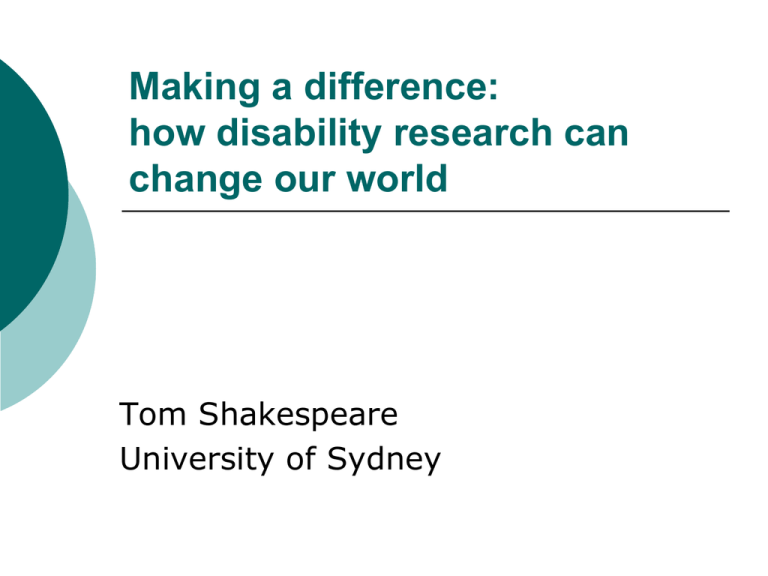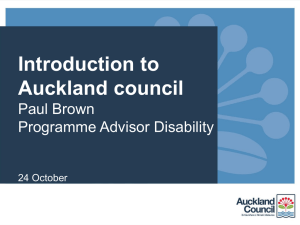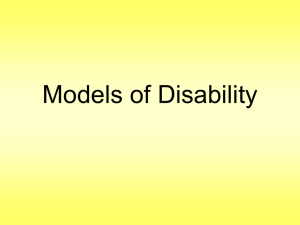Making a difference: how disability research can change our world
advertisement

Making a difference: how disability research can change our world Tom Shakespeare University of Sydney Outline The emergence of Disability Studies What should disability research look like? World report on disability Research priorities Academia versus activism Origins of disability studies Tradition of medical research Criticised as individualising, pathological Non-disabled experts researching on disabled people Resistance and rejection from disability activists Emerging academic discipline Roots in disability politics Rejection of research on ‘experience’ Focus on structural issues (public private split) Emancipatory research Research which changed Britain Colin Barnes' research for BCODP: Disabled People in Britain and Discrimination, 1991. Mike Oliver and Gerry Zarb's research on direct payments. The Sexual Politics of Disability, 1996? Disability studies claims 1. 2. 3. Disability is a social and political issue, not simply a medical or rehabilitation issue Disability is an issue of identity: “nothing about us without us” People are disabled by society, not by their bodies Examples of research traditions United Kingdom: social model focus on barriers, public/private split, political engagement North America: minority group focus, literary and cultural studies, academic discipline Nordic countries: relational model, welfare evaluation, few disabled researchers Models of disability (if you must) Individual or Medical Model Focus is on the clinical diagnosis Focus is on what someone can’t do Sees the person as the problem that needs to be fixed or cured Medical, psychological, rehabilitation as answer Structural or Social Model Focus is on the context People are disabled by society, not by their bodies Discrimination, prejudice as the problem Barrier removal as the way forward Components of ICF Health condition (disorder or disease) Body Functions Activity Participation and Structures (activity limitation) (participation restriction) (impairment) Environmental Factors Personal Factors Disability as an interaction Intrinsic factors Extrinsic factors Type of impairment Physical environments Severity of impairment Social arrangements Motivation, attitude to impairment Expectations and roles Self-esteem, confidence Cultural meanings,representations Methodologies Qualitative social research: gathering disabled people’s voices and experiences Quantitative social research: impact of impairment and illness; economic situation; attitudes; experiences of violence etc Cultural research: content analysis, cultural criticism, cultural theory Historical research Philosophical enquiry: ethics, political theory, aesthetics etc Examples of UK research (2003) Rolling through the 20th century: a sociotechnical history of the wheelchair (Edinburgh, York) (2005) Secret love, hidden lives? (Norah Fry Centre, Bristol) www.bristol.ac.uk/norahfry/online.html (2006) Disabled people and direct payments: UK comparative study www.leeds.ac.uk/disabilitystudies/projects/UKdirectpayments/index.htm (2007) Quality of life in restricted growth (Newcastle) www.restrictedgrowth.co.uk Teaching programmes should be multidisciplinary: humanities, sciences, and social sciences. challenge view of disability as individual deficit remedied solely through medical intervention or rehabilitation: should examine social, political, cultural, and economic factors. study national and international perspectives, policies, literature, culture, and history to place current ideas of disability within their broadest possible context. actively encourage participation by disabled students and faculty, and should ensure physical and intellectual access. make it a priority to have leadership positions held by disabled people, while welcoming contributions from anyone Different journals, different approaches Disability and Society Disability Studies Quarterly Scandinavian Journal of Disability Research Alter Journal of Literary Disability World report on disability Launched by WHO and World Bank at UN in 2011 380 different contributors from 70 countries Chapters on data, health, rehabilitation, assistance and support, enabling environments, education and employment Supporting implementation of Convention on Rights of Persons with Disabilities Found major gaps in research, particularly from low and middle income countries General recommendations, because evidence base did not exist Entia non sunt multiplicanda sine necessitate Priorities Improving the lives of disabled people, not just creating careers for disabled academics Empirical research, not just theory Based wherever possible on partnership with disabled people and their organizations Research in LMIC Take into account differences between disabled people Evaluation of what works Economic analysis: cost-effectiveness, costbenefit of interventions Academia vs activism Research is not activism by other means Emancipatory research can bring risks Responsibility to research participants, not to those who commission research Requirement of independence and integrity The duty of the researcher: to ask the difficult questions and to find the best possible answers, even when the truth is inconvenient, challenging or unwelcome.

![You can the presentation here [Powerpoint, 1.01MB]](http://s2.studylib.net/store/data/005417570_1-0810139cfc2485ebcaf952e0ae8bb49a-300x300.png)







